"The Home Movie award went to [Joseph] F. Hollywood for his 8mm picture 'Two Kids and a Pup.' The subject was truly home movie in nature. A brief continuity that showed the pup being brought home; both boy and girl wanted it and finally a compromise where it is agreed one day the boy is to hove the pup and the next day the girl; the children thus to alternate for peace's sake. Then is shown how the boy plays with a dog. He goes to a wooded lot, pretends to be hunting, etc. The girl, however, treats the dog the same as she would a doll. Makes clothes for it, dresses it up and places it in the doll buggy. Then comes the day when the girl decides to cheat a bit and rushes home to be the first to have the dog. When the boy arrives she has the dog completely covered in the doll buggy. However, at the crucial moment it rears its head and the fight is on. The mother then decides to settle the controversy by having the children stand at one end of the yard while she takes the dog to the other end. They are to call the dog and the one to whom the dog goes is to play with it that day. They are set, the dog is let loose and just at that moment another dog passes by and the pup rushes between the children after the other dog and thus the story ends. Hollywood's cutting and photography were good. And the handling of the whole picture was highly commendable." American Cinematographer, Jan. 1937, 25.
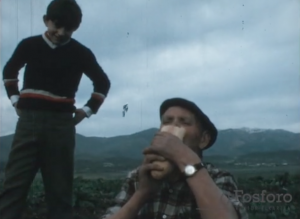
Después de que su padre parte al trabajo, un pequeño niño debe llevarle pan y vino. Sin embargo, el niño se toma mucho tiempo vistiéndose y jugando con una botella en un lago. Su madre le pide apurarse y en el camino el niño bebe el vino y rellena la botella con agua, se esconde para ver a una pareja besarse, le da a su padre el pan y después interrumpe a unos niños jugando. Mientras juegan a esconderse, él se lleva a una niña lejos y la besa, para después seguir huyendo y esconderse en un establo momentáneamente. Al caminar hacia las vías del tren, piensa en todo lo que ha hecho, y se acuesta ahí con los ojos vendados pero al reflexionar sobre sus acciones decide regresar a casa con su madre.
After his father leaves for work, a little kid has to bring him bread and wine. However he takes his time getting dressed and playing with a bottle in a lake, then his mother prompts him to hurry and on the road he drinks the wine and re-fills the bottle with water, he watches a couple kissing, then he gives his father the bread and interrupts some kids playing, then while playing hide and seek he takes a girl far away and kisses her and he keeps running away, staying hidden in a barn for a while. Then he walks to the train tracks and starts thinking of all he has done, so he lays there with his eyes blind folded but after thinking about his doings he goes back home to his mother.
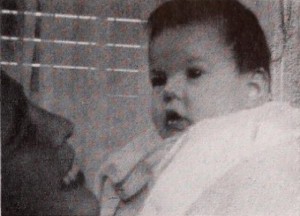
"The Unexpected, by Ernest H. Kremer, is that rara avis of the amateur movie world, a perfectly produced and universally entertaining family film. It is no secret, surely, that taking pictures of one's family outranks all other reasons prompting a home filmer to buy his camera. It is an equally open secret that the results, generally, are those that only a mother could love. Judged impersonally and by even the simplest movie standards, the technique is sloppy, camera treatment dull and continuity non-existent. But now, with The Unexpected, family film making takes on new stature and its apostles may speak with new pride. The picture tells a simple tale: A man arrives home and finds a note from his wife. Unexpectedly, she writes, she has been called to the city, but there is food in the icebox, et cetera, etc. Later that evening, after a suavely developed interlude of husbandly miming, the wife returns and announces that she expects a baby. The rest of the rewardingly short reel records early activities in the life of the infant, capped by a swift and comic climax. A simple tale, but superbly told. Mr. Kremer's technical skill, developed through years of competent 8mm. work, is more than a match for this, his first 16mm. production. Perhaps most outstanding among the picture's many fine points is its admirable economy of footage. Running a scant 325 feet of film, it has a sense of pace regrettably rare in amateur movies. Mr. Kremer, for example, recognizes the lap dissolve as a spatial transition, not a specious ornament — and he uses it as such with telling effect. His editing is crisp, his camera treatment incisive and his continuity planned and purposeful. The Unexpected, in proving that excellence can join hands with the hearthside, should be a ringing challenge to all family filmers." Movie Makers, Dec. 1948, 474-475.
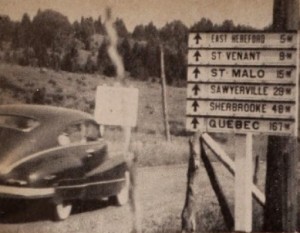
"'Vacation Highlights,' as the title implies, is a record of a vacation trip, but instead of the usual array of catch-as-can shots which make up so many vacation record films, Terry Manos has given this excellently photographed narrative substance by employing inserts of a letter to his wife and daughter, describing his trip, and a number of tie-in shots of the two to knit the whole into a pleasant continuity. The picture is remarkable, not so much from its narrative standpoint as for its consistency in exposure. There is not a measurable difference in exposure in any scene throughout the picture. The picture depicts the start of the trip by automobile, which takes the travelers across the U.S. border into Canada and thence through the province of Quebec. On the return trip they visit such interesting sights as a wood pulp mill and the famed Ausabel Chasm, in upper New York. The camera treatment of the pulpwood sequence and of the Chasm scenes definitely mark this filmer as a photographer of promise. Manos used a 16mm. Bolex camera and Kodachrome daylight type film." American Cinematographer, Apr. 1950, 134.
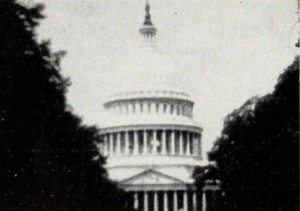
"Sometime during the summer of 1950, Fred Evans, L. A.'s genial maestro of 8mm movies, arranged to pick up a new Nash sedan in Grand Rapids, Mich. What better excuse need there be for packing up his two Southern California sons and taking them East to meet the land of their forefathers? Which is exactly what he did in Vacation Highlights of 1950. The lead title is commonplace, perhaps almost banteringly so; but the film footage which follows it is not. Niagara Falls, his native Vermont, Concord, Lexington, New York, Philadelphia and Washington are on the Evans itinerary of American history. There is a rewarding stop at the St. Louis zoo — for its incomparable Sunday shows — and soon the Evans are home again. But not without one final twist to the tale. "Hey, look-out here, Pop!" urges the oldest offspring as he returns from scouting the premises. The family cat, with inimitable feline pride and savoir faire has had kittens." Movie Makers, Dec. 1951, 410.
"A Vacation with Lucy Carlisle, Margaret Pinkham, Virginia Carlisle." oldfilm.org
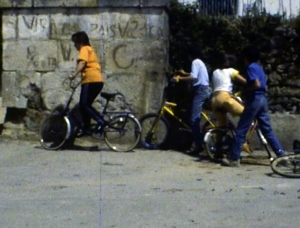
Documental corto sobre el pueblo de Villa de Corres. El filme comienza con varios paisajes de los alrededores y planos de montañas y el río. A continuación se muestra el pueblo, aparecen casas, el río, calles y algunas partes características como el Castillo, el hospital, la iglesia de San Esteban, el bebedero, la fuente , la plaza, etc. También aparecen algunas personas mayores y niños por las calles. Se comenta que es un pueblo con una población de 30 habitantes pero que es uno de los pueblos más longevos de la provincia de Álava.
Short documentary about a town called Villa de Corres. The film begins with several landscapes of the surroundings and shots of the mountains and the river. Then the film shows the town, houses, the river, streets, and some landmarks like the Castle, the hospital, the San Esteban church, the drink fountain, the fountain, the square, etc. Some older persons and children are also seen. It is said that the town only has a population of 30 persons, but that it is one of the longest-living towns in the Alava province.
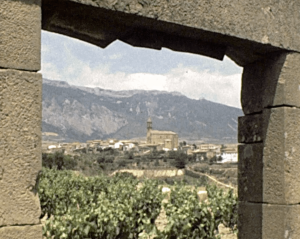
Una película que invita a hacer un viaje por la Rioja Alavesa, en especial por el pueblo de El Villar. Un recorrido que muestra los edificios, los paisajes naturales y su
gente.
A film that invites to make a trip through the Rioja Alavesa region, specially through the El Villar town. A journey that depicts buildings, natural landscapes and the people of the region.
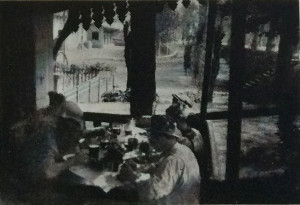
"a soggetto"/fiction
Vita, regia di Enrico Parnigotto e Fernando De Marzi. L'azione del film ha luogo in un'officina, e la trama e imperniata sulla figura di un operaio la cui moglie attende di essere madre. Egli va al lavoro come ogni mattina ma appare piuttosto preoccupato fino a ehe gli giunge la notizia della nascita di un maschio e il direttore della azienda gli concede libera uscita. L'azione è narrata con molta semplicita, e pur procedendo in taluni punti con qualche incertezza, non manca di qualche inquadratura efficace.
Vita, directed by Enrico Parnigotto and Fernando De Marzi. The action of the film takes place in a workshop, and the plot hinges on the figure of a worker whose wife is waiting to be a mother. He goes to work as every morning but appears rather worried until he gets the news of the birth of a boy and the director of the company grants him leave. The action is narrated with much simplicity, and while proceeding at some points with some uncertainty, does not lack some effective framing.
—Il ventuno 26 (Review of the G.U.F. of Venice) March 1935
"Playful family montage by the experimental filmmaker who headed the USC School of Cinematic Arts from 1949 to 1951" centerforhomemovies.org
Total Pages: 19